Tsavo East National Park is a national park in Kenya with an area of 13,747 km2 (5,308 sq mi). It was established in April 1948 and covers a semi-arid area previously known as the Taru Desert. Together with the Tsavo West National Park, it forms an area of about 22,000 square kilometers. The Tsavo River flows west to east through the national park, which is located in the Taita-Taveta County of the former Coast Province.

The hirola, also called the Hunter's hartebeest or Hunter's antelope, is a critically endangered antelope species found as of now, only in Kenya along the border of Somalia. It was first described by the big game hunter and zoologist H.C.V. Hunter in 1888. It is the only living member of the genus Beatragus, though other species are known from the fossil record. The global hirola population is estimated at 300–500 animals and there are none in captivity. According to a document produced by the International Union for Conservation of Nature "the loss of the hirola would be the first extinction of a mammalian genus on mainland Africa in modern human history".
Mwaluganje Elephant Sanctuary (MES) is a community-owned elephant park, a conservation area for elephants and Encephalartos cycads in Kwale County, Kenya.

Taita–Taveta County is a county in Kenya. Located approximately 200 km northwest of Mombasa, and 360 km southeast of Nairobi, it is a port and major gateway to the United Republic of Tanzania through Taveta. The county headquarters are located in Mwatate. It is one of the six counties in the Coastal region of Kenya. Major towns include Voi, Taveta, Mwatate, and Wundanyi.
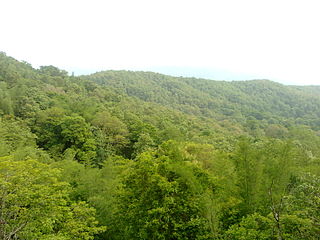
Parambikulam Tiger Reserve, which also includes the erstwhile Parambikulam Wildlife Sanctuary, is a 643.66 square kilometres (248.5 sq mi) protected area lying in Palakkad district and Thrissur district of Kerala state, South India. The Wildlife Sanctuary, which had an area of 285 square kilometres (110 sq mi) was established in part in 1973 and 1984. It is in the Sungam range of hills between the Anaimalai Hills and Nelliampathy Hills. Parambikulam Wildlife Sanctuary was declared as part of the Parambikulam Tiger Reserve on 19 February 2010. Including the buffer zone, the tiger reserve has a span of 643.66 km2. The Western Ghats, Anamalai Sub-Cluster, including all of Parambikulam Wildlife Sanctuary, has been declared by the UNESCO World Heritage Committee as a World Heritage Site. The Tiger Reserve is the home of four different tribes of indigenous peoples including the Kadar, Malasar tribe, Muduvar and Mala Malasar settled in six colonies. Parambikulam Tiger Reserve implements the Project Tiger scheme along with various other programs of the Government of India and the Government of Kerala. The operational aspects of administering a tiger reserve is as per the scheme laid down by the National Tiger Conservation Authority. People from tribal colonies inside the reserve are engaged as guides for treks and safaris, and are provided employment through various eco-tourism initiatives. Parambikulam Tiger Reserve is among the top-ten best managed Tiger Reserve in India. The tiger reserve hosts many capacity building training programmes conducted by Parambikulam Tiger Conservation Foundation in association with various organisations.
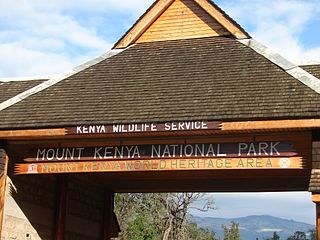
Kenya Wildlife Service (KWS) is a state corporation under the Ministry of Tourism and Wildlife established by an act of Parliament; Wildlife Conservation and Management Act CAP 376, of 1989, now repealed and replaced by the Wildlife Conservation and Management Act, 2013. At independence, the Government of Kenya committed itself to conserving wildlife for posterity with all the means at its disposal, including the places animals lived, forests and water catchment areas.

Taita Hills Wildlife Sanctuary is a privately owned wildlife sanctuary and national park in Kenya established in 1972 by Hilton international. It is located in Taita-Taveta County approximately 220 kilometers from Mombasa and 360 km south of Nairobi. The sanctuary covers an area of 28,000 acres (110 km2), and is adjacent to Tsavo West National Park and the LUMO Community Wildlife Sanctuary. It hosts cape buffalo, African bush elephant, leopard, lion, cheetah, Masai giraffe, zebra, hartebeest, impala, waterbuck, Thomson's gazelle, lesser kudu, dik-dik, Hyena, and other smaller animals, including a diversity of birdlife
The Arawale National Reserve is a designated conservation area managed by the Garissa County in assistance with the Kenya Wildlife Service. It lies in North Eastern Province of Kenya, 77 km south of the town of Garissa. The reserve covers an area of 53,324 hectares. To the west, it is bordered by the Tana River and, to the east, by the Garissa-Lamu road. In 1974, the reserve was gazetted as the only in-situ conservation site for the critically endangered Hirola population endemic to north-eastern Kenya and south-west Somalia.
The Ishaqbini Hirola Conservancy is a community-based conservation area located in Garissa County, Kenya. The conservancy covers approximately 72 km2. It is located along the eastern bank of the Tana River, and borders the former Tana River Primate Reserve (1976−2007).
The Bour-Algi Giraffe Sanctuary is a community-based conservation and natural resource management initiative. The sanctuary is located in Garissa County, Kenya, in the area surrounding the village of Bour-Algi, 5 km south of Garissa town. The sanctuary covers an area of around 125 km² and borders the Tana River to the south-west. Its name stems from the large presence of giraffes attracted by the abundant acacia trees. Estimates state almost 1000 giraffes living in the outskirts of the Bour-Algi village.

The Australian Wildlife Conservancy (AWC) is an independent Australian nonprofit organisation, working to conserve threatened wildlife and ecosystems in Australia. AWC is the largest private owner and manager of land for conservation in Australia, currently managing 31 sanctuaries and partnership sites for wildlife conservation that cover over 6.5 million hectares of land across Australia. It partners with governmental agencies, Indigenous groups, and private landholders to manage landscapes for effective conservation. Most funding comes from private support in the form of tax-deductible donations from the public, as well as some government grants for particular purposes, such as from the Australian government's National Reserve System Program.
Tsavo West National Park is located in Taita-Taveta County of Kenya. The park covers an area of 9,065 square kilometres. The A109 road Nairobi-Mombasa and a railway divides it from the adjoining Tsavo East National Park. Together with adjoining ranches and protected areas, they comprise the Tsavo Conservation Area. Tsavo West is a more popular destination due to its magnificent scenery and the Mzima Springs, the rich and varied wildlife, a good road system, a rhino reserve, rock climbing potential and guided walks along the Tsavo River. The park is operated by Kenya Wildlife Service.
Lualenyi Ranch is a private group ranch in Kenya. The ranch is located in Taita-Taveta County next to the Tsavo West National Park and Taita Hills Wildlife Sanctuary. The ranch covers approximately 106,000 acres (430 km2). It has been leased from the government for 99 years. Lualenyi Ranch is part of the LUMO Community Wildlife Sanctuary with Oza and Mramba ranches.
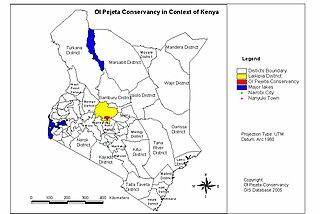
The Ol Pejeta Conservancy is a 360 km2 (140 sq mi) not-for-profit wildlife conservancy in Central Kenya's Laikipia County. It is situated on the equator west of Nanyuki, between the foothills of the Aberdares and Mount Kenya. The Ol Pejeta Conservancy works to conserve wildlife, provide a sanctuary for great apes, and generate income through wildlife tourism and complementary enterprises for re-investment in conservation and community development.
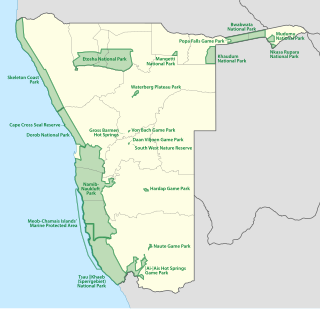
The protected areas of Namibia include its national parks and reserves. With the 2010 declaration of Dorob National Park, Namibia became the first and only country to have its entire coastline protected through a national parks network. Protected areas are subdivided into game reserves and/or nature reserves, such as special protected area, wilderness areas, natural areas, and development areas. There are also recreation reserves. Facilities in the national parks are operated by Namibia Wildlife Resorts. Over 19% of Namibia is protected, an area of some 130,000 square kilometres. However, the Ministry of Environment & Tourism auctions limited hunting rights within its protected areas. The Namibia Nature Foundation, an NGO, was established in 1987 to raise and administer funds for the conservation of wildlife and protected area management. Communal Wildlife Conservancies in Namibia help promote sustainable natural resource management by giving local communities rights to wildlife management and tourism.
Taita-Taveta District was a district of Kenya, located in the Coast Province of that country. It lies approximately 200 km northwest of Mombasa and 360 km southeast of Nairobi city.
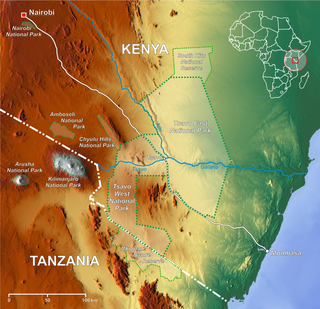
The Tsavo Trust is a non-profit wildlife conservation organisation, which covers Tsavo East National Park, Tsavo West National Park, and Chyulu Hills National Park in Kenya. The trust was founded by Nzioki Wa Makau and Richard Moller who is chief executive officer and an experienced bush pilot. The started aim of the trust is the protection of wildlife, especially African elephants, and the reduction of the ivory trade. In June 2014, the Tsavo Trust came into the international spotlight when it announced the death of Kenya's iconic and most well-known elephant, Satao, killed by an ivory poacher with a poisoned arrow.
The Tsavo Conservation Area is a complex of protected and other wildlife areas in southern Kenya and north-eastern Tanzania. It is composed of Tsavo East National Park, Tsavo West National Park, Chyulu Hills National Park, South Kitui National Reserve, ranches in Galana, Taita, Kulalu and Amboseli and adjacent private and communal lands. Bordering Mkomazi National Park in Tanzania, the Tsavo Conservation Area comprises an area of around 42,000 km2, of which over 25,000 km2 is protected. The protected portion in Kenya represent almost half of the country's protected areas.
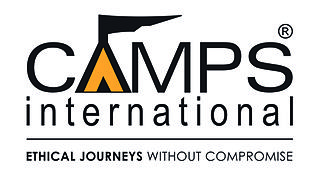
Camps International Ltd is an international volunteer travel operator headquartered in Ringwood, Hampshire UK, Dubai, UAE and Australia. Camps International build permanent volunteer accommodation camps within Kenya, Tanzania, Uganda, Borneo, Cambodia, Ecuador and Peru. Its products include adventure expeditions, educational school expeditions for UK, UAE and Australian school groups.











